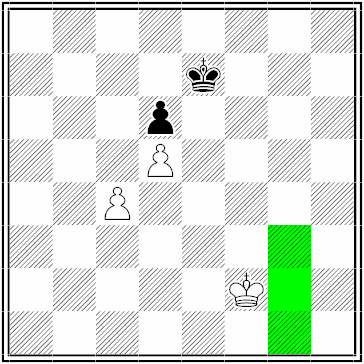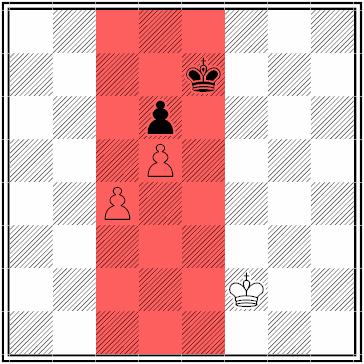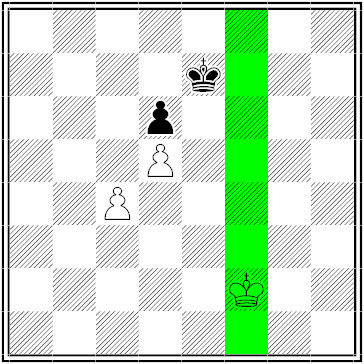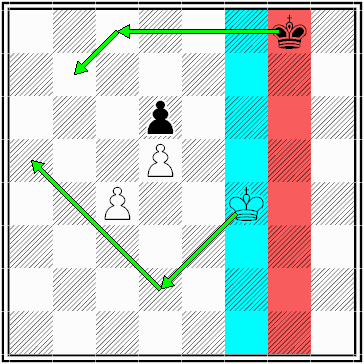Seeing the invisible
In books about endgames there are always a lot of positions from composers to study.
SOPE is no exception.
The problem with that is that a composer always tries to generate the most exotic position.
Allthough that's good to show the beauty of the game, it's not very helpful if you want to learn the game.
For that you have to find the most common positions and analyze them thoroughly.
I have done that for you for the following position.
diagram 1

White to move and win.
To evoke your curiousness I coloured the winning moves for white.
All other moves result in a draw.
First you have to understand what this position is all about.
In order to win white has to conquer the black pawn.
To that end you have to know what the keysquares are (see diagram 2)
diagram 2

The keysquares are coloured blue.
So white has two targets to head for.
The only way black can defend the keysquares is by opposition.
If white moves to b5 then black has to occupy b7.
The same with f5 - f7 and so on.
So the opposition is decisive.
Because of the pawns there is an area where the opposition has no meaning.
I call this the shadow-area.
(coloured red in diagram 3)
diagram 3

If both kings are in the shadow area they can't approach each other because of the pawns who are in their way. If black is on the same file as white in the shadow area, the position is a draw.
This works as follows: if white leaves the shadow, black does the same, but chooses immediate the opposition. If white wants to cross the shadow, he has to make sure the black king isn't on the same file
Further the area of black is limited because he has to stay in the square of pawn d5, to prevent a pawn sac.
So if the first move of white is e1, e2 or e3 (step into the shadow) the position is a draw.
diagram 4

If white stays on the green line (by 1.Kf1 or 1.Kf3) black can get the opposition by 1. ...Kf7 (distant opposition, same color)
The green file is the file were the first opposition can take place.
The only way to prevent that black can seize the opposition is by going to the g-file.
1.Kg3 is the most effective, because it heads towards the keysquares, but 1.Kg1 and 1.Kg2 don't give the advantage away.
In the next diagram the paths of both kings are shown.
Black isn't allowed to get the opposition.
Hence the zigzag
diagram 5

White to move first. Every time black threatens so seize the opposition, white escapes to the g-file. The moment black steps to the g-file it is time to change targets and to head for a5.
(see diagram 6)
diagram 6

Since white's king can stay always 1 file to the left of the file of the black king, black can't overtake white in time. So when white moves to a5, black steps on the b7 square.
The next move white takes the opposition with Kb5 and the black pawn will be lost.
When you see these invisible patterns, the win is easy. Without them, it is near to impossible to calculate them accurate in a few minutes.
The position above is very common. When you move the same position up and down along the ranks, or to the left or right, diffirent situations appear. But it helps to know the common idea's.
I hope you like the analysis.
SOPE is no exception.
The problem with that is that a composer always tries to generate the most exotic position.
Allthough that's good to show the beauty of the game, it's not very helpful if you want to learn the game.
For that you have to find the most common positions and analyze them thoroughly.
I have done that for you for the following position.
diagram 1

White to move and win.
To evoke your curiousness I coloured the winning moves for white.
All other moves result in a draw.
First you have to understand what this position is all about.
In order to win white has to conquer the black pawn.
To that end you have to know what the keysquares are (see diagram 2)
diagram 2

The keysquares are coloured blue.
So white has two targets to head for.
The only way black can defend the keysquares is by opposition.
If white moves to b5 then black has to occupy b7.
The same with f5 - f7 and so on.
So the opposition is decisive.
Because of the pawns there is an area where the opposition has no meaning.
I call this the shadow-area.
(coloured red in diagram 3)
diagram 3

If both kings are in the shadow area they can't approach each other because of the pawns who are in their way. If black is on the same file as white in the shadow area, the position is a draw.
This works as follows: if white leaves the shadow, black does the same, but chooses immediate the opposition. If white wants to cross the shadow, he has to make sure the black king isn't on the same file
Further the area of black is limited because he has to stay in the square of pawn d5, to prevent a pawn sac.
So if the first move of white is e1, e2 or e3 (step into the shadow) the position is a draw.
diagram 4

If white stays on the green line (by 1.Kf1 or 1.Kf3) black can get the opposition by 1. ...Kf7 (distant opposition, same color)
The green file is the file were the first opposition can take place.
The only way to prevent that black can seize the opposition is by going to the g-file.
1.Kg3 is the most effective, because it heads towards the keysquares, but 1.Kg1 and 1.Kg2 don't give the advantage away.
In the next diagram the paths of both kings are shown.
Black isn't allowed to get the opposition.
Hence the zigzag
diagram 5

White to move first. Every time black threatens so seize the opposition, white escapes to the g-file. The moment black steps to the g-file it is time to change targets and to head for a5.
(see diagram 6)
diagram 6

Since white's king can stay always 1 file to the left of the file of the black king, black can't overtake white in time. So when white moves to a5, black steps on the b7 square.
The next move white takes the opposition with Kb5 and the black pawn will be lost.
When you see these invisible patterns, the win is easy. Without them, it is near to impossible to calculate them accurate in a few minutes.
The position above is very common. When you move the same position up and down along the ranks, or to the left or right, diffirent situations appear. But it helps to know the common idea's.
I hope you like the analysis.
First of all, your post is terrific and very instructive, and you deserve applause.
ReplyDeleteI have one minor beef, though. I disagree completely that chess composers try to come up with the most "exotic" positions.
Take for example Irving Chernev's collection 'Procatical Chess Endings".
These are all endgame composed studies, yet a quick perusal will verify that these positions could all quite easily appear in a real game.
Look at GM Larry Evan's recent "Chess Endgame Quiz". Half composed positions, half real GM games. You really can't tell the difference which are which if you cover up the captions.
There's nothing wrong with compositions or composers. On the contrary. Their work is invaluable for understanding endgames.
ReplyDeleteWhat I wanted to indicate is that there is an area in endings that isn't covered by compositions, but that needs coverage nevertheless.
You will not find the example I give here in a book with compositions. Compositions have a few (unwritten?) rules that determine whether a composition is good or not good.I specially tried to make this example as common as possible. You can shift the position up and down, to the right and to the left, but the main ideas stay the same. It has 3 solutions, which is unusual for a composition (the composition is "cooked"). So it would win no prize:)
Great post! The concept of shadow area is new for me, and I find it very useful.
ReplyDeleteIt is nice to see your "flamethrower in action". I think I am at the peashooter level. Nice post.
ReplyDeleteTempo,
ReplyDeleteThis is one of your best posts by far. Very instructive. I imagine taking the time to teach us, only further cements the concepts for you. Thank you for your effort and expertise.
Very nice site!
ReplyDeleteActually, that's not true about sliding the position up and down, and left and right. For instance if you slide it up one square, the white king is free to move into the e-file because the black king doesn't have the option to back up on the e-file. There's something about having two squares of king freedom that make certain things work. If you slide the position one square left, the white king loses the option to move between the a and b file and thus, all hope for white is gone, it's a draw. Similarly, if the position slides two squares to the right, white loses the necessary freedom to move laterally between the two righmost files(g and h) and again, the position is drawn.
ReplyDeleteThere's something about binary choice, right and left, and up and down in critical opposition positions that need to be recognized.
Temposchlucker: what a great series of endgame posts! It's funny, it seems I am inadvertently and independently following the same path you were down nine years ago.
Thanks again. Best regards, Brian.